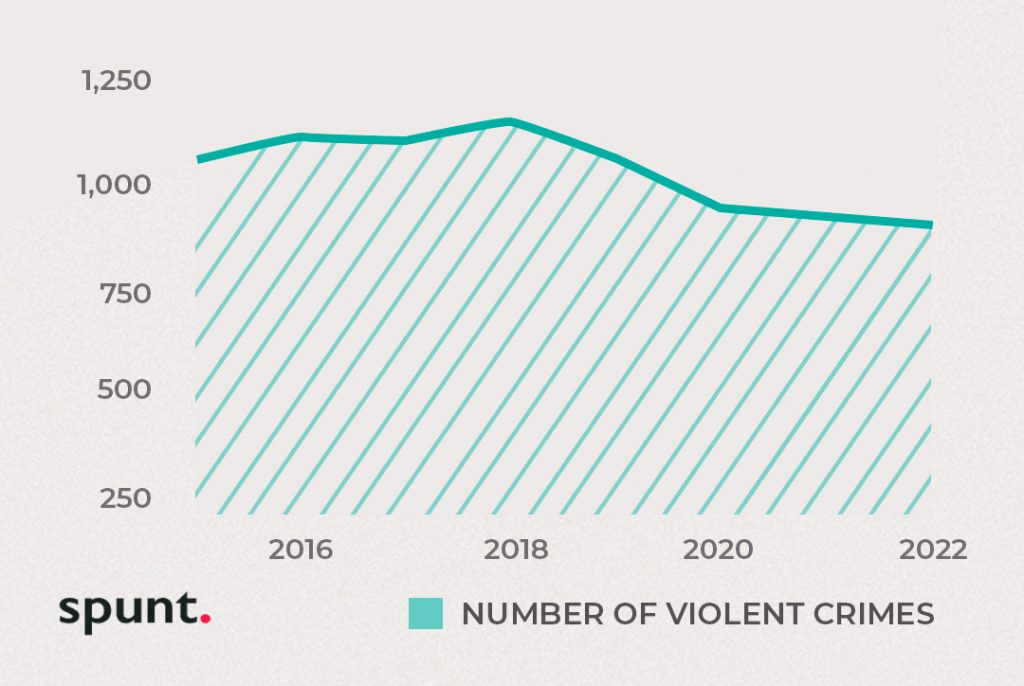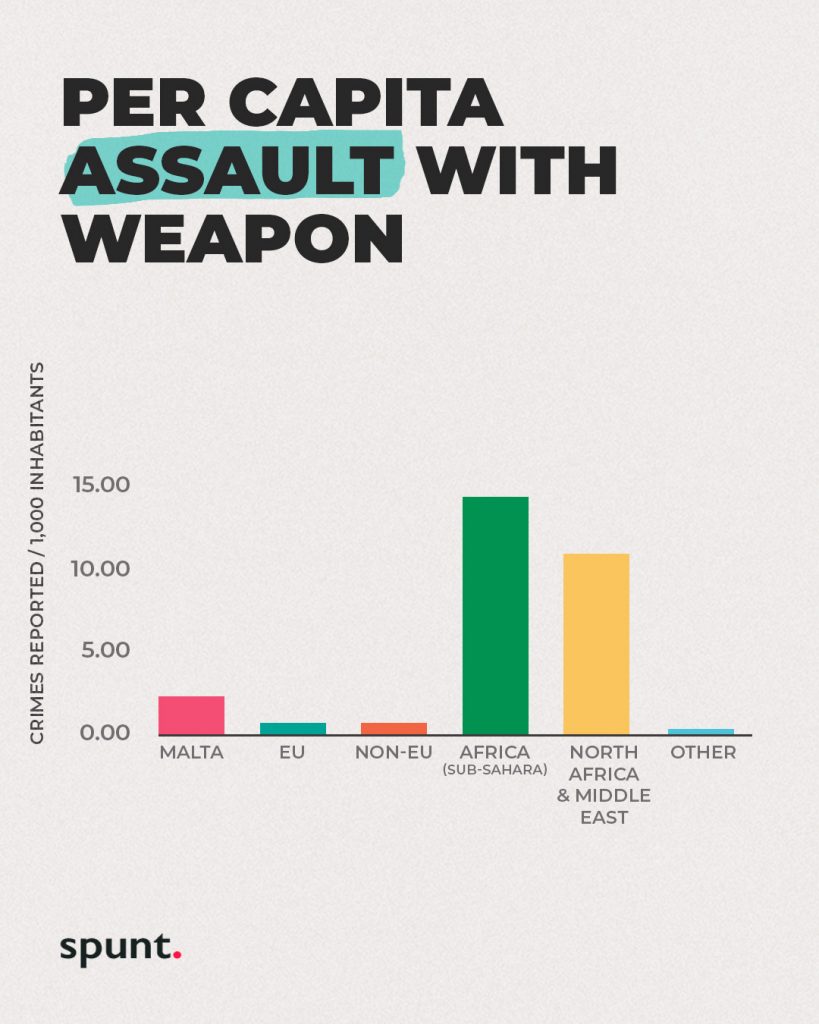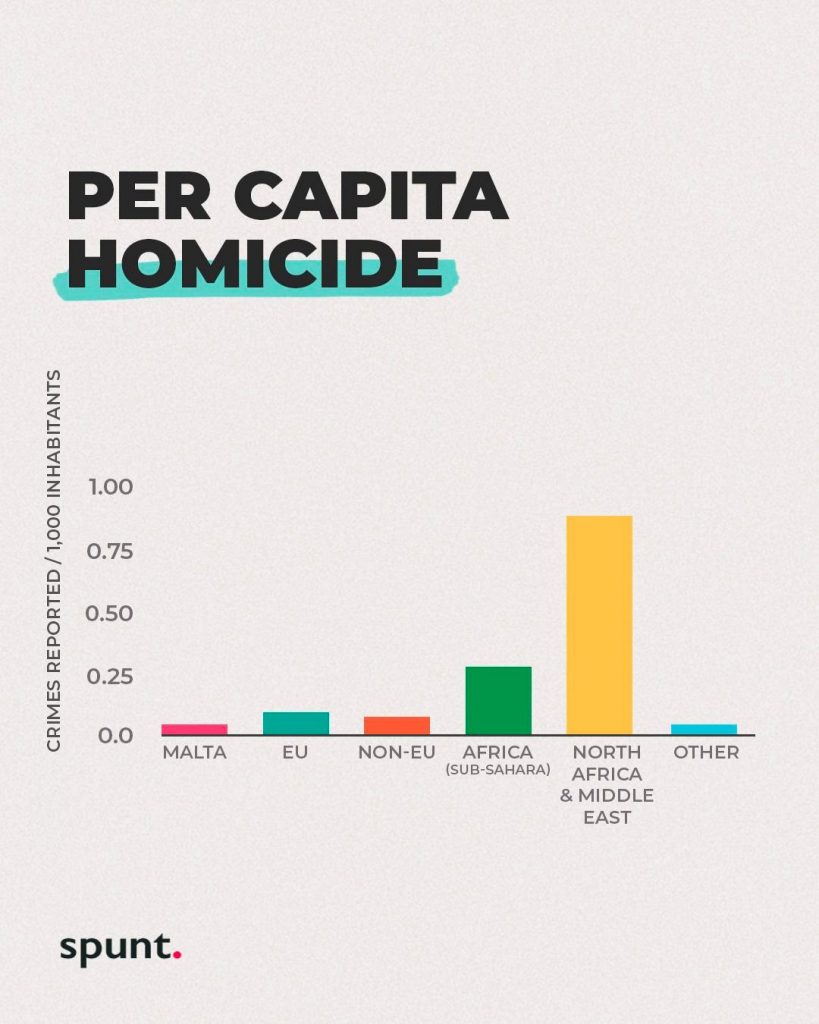Over the past decade, Malta has witnessed significant demographic shifts. From 2015 to 2022, the total population grew from 450,415 to 522,530, marking a 16% increase. These demographic changes raise pertinent questions. As the population swells and diversifies, there are natural concerns about how this influx has impacted the crime in Malta.
Despite this growth, the number of reported violent crimes shows a different trend. In 2015, there were 1,056 reported cases, which is lower than the 814 cases reported in 2022. This downward trajectory indicates that the recent increase in population did not translate into a corresponding rise in reported cases of violent crime.

Violent crime is a broad term encompassing various transgressions such as assault, theft, sexual offenses, and homicide. The decline in its reported cases, juxtaposed against the backdrop of a growing population, is a significant observation. It prompts further exploration into the intricacies of these trends and their implications for the island’s safety and security landscape.
Categorization by Nationality
To offer further insight into how the population increase and diversification have influenced patterns of crime in Malta, we break down the resident population into the following groups: Maltese (native), EU, Non-EU, African, and Other*.
Note : ‘Other’ refers to population groups whose data points are so small that they would need to be aggregated to be statistically relevant for the purposes of this report.
The importance of per capita analysis
Examining the data in per capita terms is vital. It allows us to better understand certain characteristics of the aggressor. Essentially, per capita figures measure the occurrence of crimes in relation to the population, typically expressed as the number of crimes per person. This method provides a clearer picture of crime rates, especially in places with diverse population densities and sizes.
Data analysis on crime in Malta
Upon examining the crime rates across various population groups in Malta, certain patterns emerge about crime in Malta. When we consider “Assault without a Weapon,” the Maltese native population stands at a rate of 11.85 per 1,000. This rate is more than double that of the EU population, which has a rate of 5.59 per 1,000, and the Non-EU European group, which is at 4.42 per 1,000. However, it’s worth noting that the Sub-Saharan African and North African & Middle Eastern groups have significantly higher rates at 21.47 and 21.03 per 1,000, respectively. In contrast, the ‘Other’ category presents a much lower rate of 2.14 per 1,000.
For “Assault with a Weapon,” the Maltese native rate is 2.30 per 1,000, which, when compared to the EU’s 0.66 and Non-EU European’s 0.82, is considerably higher. Yet, the rates for the Sub-Saharan African group (14.16) and the North African & Middle Eastern group (10.93) eclipse these figures. The ‘Other’ category has a minimal rate of 0.35 per 1,000.

In the “Armed Robbery” category, the Maltese native rate is 0.27 per 1,000. The EU population has a very low rate of 0.05, and intriguingly, there are no reported cases for the Non-EU European group. The Sub-Saharan African group has a rate of 0.09, while the North African & Middle Eastern group sees a more substantial rate at 0.75. The ‘Other’ category remains consistent with its low figures, showing a rate of 0.04.
When examining “Homicide,” the Maltese natives and the ‘Other’ category both have a rate of 0.04 per 1,000. The EU and Non-EU European groups present slightly higher rates, both at 0.07. However, the Sub-Saharan African and North African & Middle Eastern groups showcase rates at 0.28 and 0.89, respectively.

For “Violent Indecent Assault,” the Maltese natives have a rate of 0.26 per 1,000, while the EU’s rate is slightly lower at 0.17. The Non-EU European group’s rate is 0.22. However, the Sub-Saharan African group’s rate jumps to 1.85, and the North African & Middle Eastern group follows closely with 1.57. The ‘Other’ group has a rate of 0.12.
Considering “Rape,” the Maltese natives have a rate of 0.15 per 1,000, which is slightly lower than the EU’s 0.24 and the Non-EU European’s 0.22. The Sub-Saharan African group’s rate stands at 1.02. Data for the North African & Middle Eastern group in this category was not provided, and there were no reported cases for the ‘Other’ group.

In the “Indecent Exposure” category, the Maltese natives have a rate of 0.20 per 1,000. The EU’s rate is slightly higher at 0.28, while the Non-EU European group has a rate of 0.15. The rates for the Sub-Saharan African and North African & Middle Eastern groups are 1.11 and 0.34, respectively. The ‘Other’ category remains low at 0.04.
Lastly, for “Mugging,” the Maltese natives and the Non-EU European group both have a rate of 0.15 per 1,000. The EU’s rate is lower at 0.07. The Sub-Saharan African group has a rate of 1.48, and the North African & Middle Eastern group follows with 0.96. The ‘Other’ category had no reported cases of this type of crime in Malta.

Summarized analysis
While Malta’s population has grown significantly over the past decade, it’s crucial to analyze crime statistics in a nuanced manner, taking into account the diverse backgrounds and population sizes. The per capita analysis provides a more in-depth insight into the true state of crime in Malta. As the island continues to grow and diversify, understanding these patterns becomes essential for ensuring safety and harmony among all residents.
From this in-depth analysis, it becomes clear that while the Maltese natives and European groups (both EU and Non-EU) exhibit relatively lower rates for most crime categories. The ‘Other’ category, representative of an aggregation of all other population groups, consistently demonstrates the lowest crime rates across the board. On the other hand Sub-Saharan African and North African & Middle Eastern groups present higher incidences, particularly in assaults and violent indecent assaults.
It is also worth noting that, as with all crime statistics, these can only take into account reported crimes. Any crimes that are not reported to the police are completely absent in these analyses. Additionally, per capita statistics, while very useful for the reasons stated above, can paint a disproportionate picture if the target demographic is not of a significant size.
References
Appendix B – references Ministry for Home Affairs, National Security and Law Enforcement – Freedom of Information request made on the 27th January 2023
National Statistics Office (NSO) – Information request made on the 17th of September 2020
National Statistics Office (NSO) – Census of Population and Housing 2021

Leave a Reply